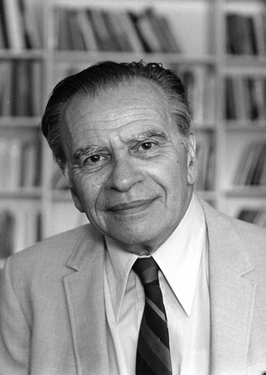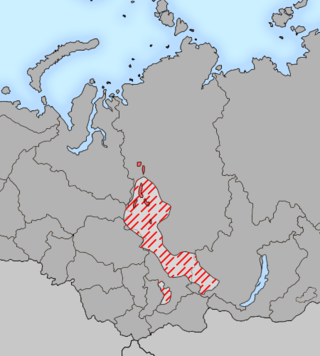Related Research Articles

Joseph Harold Greenberg was an American linguist, known mainly for his work concerning linguistic typology and the genetic classification of languages.
The Ket language, or more specifically Imbak and formerly known as Yenisei Ostyak, is a Siberian language long thought to be an isolate, the sole surviving language of a Yeniseian language family. It is spoken along the middle Yenisei basin by the Ket people.
The Paleo-Siberian languages are several language isolates and small language families spoken in parts of Siberia. They are not known to have any genetic relationship to each other; their only common link is that they are held to have antedated the more dominant languages, particularly Tungusic and latterly Turkic languages, that have largely displaced them. Even more recently, Turkic and especially Tungusic have been displaced in their turn by Russian.

Athabaskan is a large family of indigenous languages of North America, located in western North America in three areal language groups: Northern, Pacific Coast and Southern. Kari and Potter (2010:10) place the total territory of the 53 Athabaskan languages at 4,022,000 square kilometres (1,553,000 sq mi).

Na-Dene is a family of Native American languages that includes at least the Athabaskan languages, Eyak, and Tlingit languages. Haida was formerly included, but is now considered doubtful. By far the most widely spoken Na-Dene language today is Navajo.

The Yeniseian languages are a family of languages that are spoken by the Yeniseian people in the Yenisei River region of central Siberia. As part of the proposed Dené–Yeniseian language family, the Yeniseian languages have been argued to be part of "the first demonstration of a genealogical link between Old World and New World language families that meets the standards of traditional comparative-historical linguistics". The only surviving language of the group today is Ket.

Kets are a Yeniseian-speaking people in Siberia. During the Russian Empire, they were known as Ostyaks, without differentiating them from several other Siberian people. Later, they became known as Yenisei Ostyaks because they lived in the middle and lower basin of the Yenisei River in the Krasnoyarsk Krai district of Russia. The modern Kets lived along the eastern middle stretch of the river before being assimilated politically into Russia between the 17th and 19th centuries. According to the 2010 census, there were 1,220 Kets in Russia. According to the 2021 census, this number had declined to 1,088.

Merritt Ruhlen was an American linguist who worked on the classification of languages and what this reveals about the origin and evolution of modern humans. Amongst other linguists, Ruhlen's work was recognized as standing outside the mainstream of comparative-historical linguistics. He was the principal advocate and defender of Joseph Greenberg's approach to language classification.

Dené–Caucasian is a proposed language family that includes widely-separated language groups spoken in the Northern Hemisphere: Sino-Tibetan languages, Yeniseian languages, Burushaski and North Caucasian languages in Asia; Na-Dené languages in North America; and the Vasconic languages from Europe.

Michael E. Krauss was an American linguist, professor emeritus, founder and long-time head of the Alaska Native Language Center. He died on August 11, 2019, four days before his 85th birthday. The Alaska Native Language Archive is named after him.

Uralo-Siberian is a hypothetical language family consisting of Uralic, Yukaghir, and Eskaleut. It was proposed in 1998 by Michael Fortescue, an expert in Eskaleut and Chukotko-Kamchatkan, in his book Language Relations across Bering Strait. Some have attempted to include Nivkh in Uralo-Siberian. Until 2011, it also included Chukotko-Kamchatkan. However, after 2011 Fortescue only included Uralic, Yukaghir and Eskaleut in the theory, although he argued that Uralo-Siberian languages have influenced Chukotko-Kamchatkan. It is considered a fringe theory by linguists.
John D. Bengtson is an American historical and anthropological linguist. He is past president and currently vice-president of the Association for the Study of Language in Prehistory, and has served as editor of the journal Mother Tongue. Since 2001 he has been a member/researcher of Evolution of Human Languages, an international project on the linguistic prehistory of humanity coordinated by the Santa Fe Institute. His areas of specialization include Scandinavian languages and linguistics, Indo-European linguistics, Dené–Caucasian (Sino-Caucasian) languages, and paleolinguistics.

Karasuk is a hypothetical language family that links the Yeniseian languages of central Siberia with the Burushaski language of northern Pakistan.
James Kari is a linguist and Professor Emeritus with the Alaska Native Language Center at the University of Alaska Fairbanks (UAF) specializing in the Dene of Alaska. For over fifty years he has done extensive linguistic work in many Dene languages including Ahtna, Dena'ina, Koyukon, Deg Hit'an, Holikachuk, Lower Tanana, Middle Tanana, Tanacross, Upper Tanana, and Babine-Witsuwit'en. He was on the faculty of UAF from 1973 until his retirement in 1997. He continues to work on numerous Alaska Native language projects. He is the author or editor of over 200 publications, including more than 4000 pages of bilingual texts in seven Dene languages. He is the most prolific contributor to the Alaska Native Language Archive. His special interest is Dene ethnogeography, and he has compiled or documented more than 14,000 place names in fourteen Alaska or Canadian Dene languages. He worked with Dena'ina writer and ethnographer Peter Kalifornsky on a 1991 compilation of his creative writings. In 2008 he was the organizer of the Dene–Yeniseian Symposium in Alaska, and co-editor of the volume The Dene–Yeniseian Connection published in 2010. In 2009 was selected Kari for the Alaska Governor's Award for the Humanities. In March 2013 Kari received the Professional Achievement Award at the 40th annual meeting of the Alaska Anthropological Association. In 2019 he was presented with a volume of papers by colleagues that recognize his career in Dene research.
Dené–Yeniseian is a proposed language family consisting of the Yeniseian languages of central Siberia and the Na-Dené languages of northwestern North America.
Martin Haspelmath is a German linguist working in the field of linguistic typology. He is a researcher at the Max Planck Institute for Evolutionary Anthropology in Leipzig, where he worked from 1998 to 2015 and again since 2020. Between 2015 and 2020, he worked at the Max Planck Institute for the Science of Human History. He is also an honorary professor of linguistics at the University of Leipzig.
Proto-Athabaskan is the reconstructed ancestor of the Athabaskan languages.
Proto-Yeniseian or Proto-Yeniseic is the unattested reconstructed proto-language from which all Yeniseian languages are thought to descend from. It is uncertain whether Proto-Yeniseian had a similar tone/pitch accent system as Ket. Many studies about Proto-Yeniseian phonology have been done, however there are still many things unclear about Proto-Yeniseian. The probable location of the Yeniseian homeland is proposed on the basis of geographic names and genetic studies, which suggests a homeland in Southern Siberia.

The Yeniseian people are a Siberian population that speaks Yeniseian languages. Despite evidence pointing to the historical presence of Yeniseian populations throughout Central Siberia and Northern Mongolia, only the Ket and Yugh people survive today. The modern Yeniseians live along the eastern middle stretch of the Yenisei River in Northern Siberia. According to the 2021 census, there were 1,088 Kets and 7 Yugs in Russia.
The Kott people were a Yeniseian-speaking people in Siberia. They were closely related to the Asan people. They spoke the Kott language which went extinct in the mid-1800s along with the ethnicity.
References
- ↑ Entry on Edward Vajda in Encyclopedia.com
- ↑ Bill Poser. "The languages of the Caucasus". Language Log, 25 August 2008. Accessed 22 July 2017.